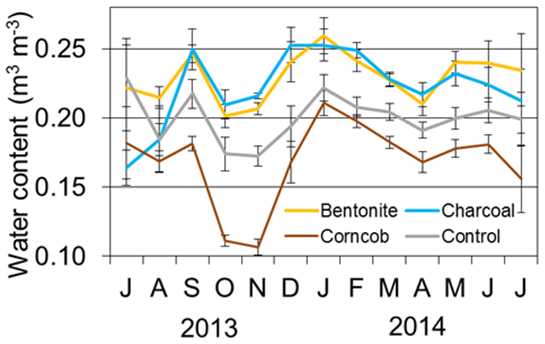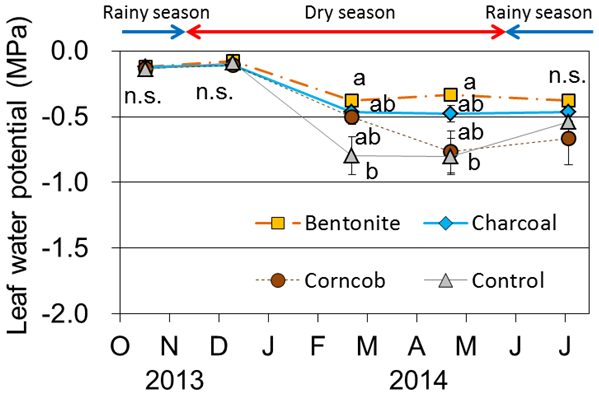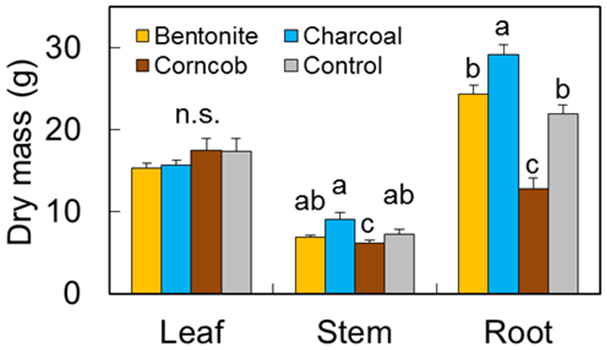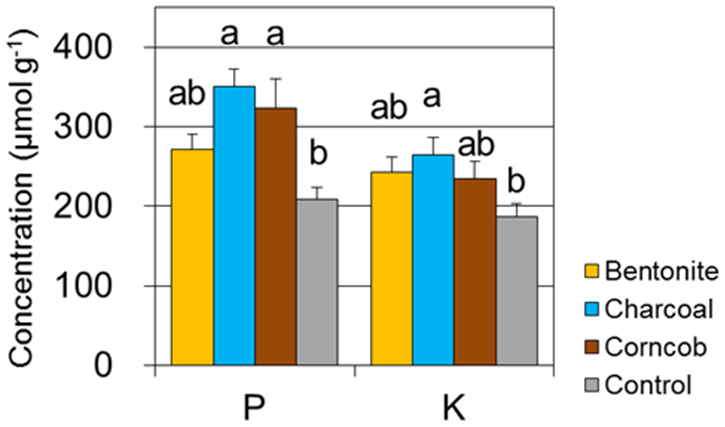Addition of charcoal to sandy soil in Northeast Thailand enhances growth of teak
Description
Teak (Tectona grandis L. f.) is one of the most valuable timber tree species in Thailand, and it is widely planted throughout the country. However, teak growth in Northeast Thailand plantations is suppressed due to the low pH, low fertility, and low water holding capacity of the underlying sandy soil. Soil acidity can be corrected to raise the pH levels and fertilizers can be applied to improve the fertility of sandy soils, thereby accelerating the growth of teak. There have been previous researches on improving the water holding capacity of sandy soil, and some materials have been shown to be effective. However, these past studies did not examine the effect of these materials on the growth of teak.
In this study, we examined the availability of materials to improve the sandy soil’s water holding capacity and increase teak growth. We selected bentonite (a clay consisting mostly of montmorillonite), charcoal, and corncob, and added these materials at the rate of 4% (by weight) to sandy soil in Northeast Thailand. The mixtures were put into 8.5-L pots, and teak seedlings were planted on these pots and raised for one year. We measured soil water content and leaf water potential at predawn. At the end of the experiment, we sampled the teak seedlings, measured the dry mass of each organ, and analyzed the concentration of nutrients in leaves. Lastly, we compared the parameters among bentonite, charcoal, corncob, and no addition (control) treatments.
Results showed that water content was high for the bentonite treatment throughout the whole period (Fig. 1). For the charcoal treatment, water content increased from September 2013. In contrast, the corncob treatment showed low water content compared with the three other treatments. The predawn leaf water potential did not decrease for bentonite and charcoal treatments (Fig. 2). Moreover, teak seedlings grown on bentonite- and charcoal-treated plots could uptake water from the soil during the whole period and did not suffer from drought stress.
Charcoal treatment showed significantly higher root dry mass compared with the other treatments despite no fertilization (Fig. 3). The concentrations of phosphorus and potassium in the leaves of teak seedlings were significantly higher for the charcoal treatment compared with the control treatment (Fig. 4). In contrast, bentonite treatment did not show high concentrations of nutrients in leaves.
Based on our experiment, we concluded that charcoal was the most suitable material among those tested and would be very useful for improving teak growth at the seedling stage in sandy soils in Northeast Thailand. Charcoal is commonly produced in various countries, and thus may be applied as soil improvement material to enhance the water holding capacity and uptake of phosphorus.
Figure, table
-
Fig. 1. Average soil water content before irrigation or rainfall (from July 2013 to July 2014)
-
Fig. 2. Predawn leaf water potential of teak leaves (from October 2013 to July 2014)
-
Fig. 3. Dry mass of each plant organ at the end of experiment (July 2014)
-
Fig. 4. Concentrations of phosphorus and potassium in teak leaves at the end of the experiment (July 2014)
- Affiliation
-
Japan International Research Center for Agricultural Sciences Forestry Division
- Research project
- Program name
- Term of research
-
FY2016(FY2011~FY2015)
- Responsible researcher
-
Kayama Masazumi ( Forestry Division )
ORCID ID0000-0002-6145-2241KAKEN Researcher No.: 60435584Nimpila Suchat ( Forest Research and Development Bureau, Royal Forest Department, Thailand )
Hongthong Sutjaporn ( Forest Research and Development Bureau, Royal Forest Department, Thailand )
Wichiennopparat Wilawan ( Forest Research and Development Bureau, Royal Forest Department, Thailand )
Himmapan Woraphun ( Forest Research and Development Bureau, Royal Forest Department, Thailand )
Vacharangkura Tosporn ( Forest Research and Development Bureau, Royal Forest Department, Thailand )
Yoneda Reiji ( Forestry and Forest Products Research Institute )
KAKEN Researcher No.: 00435588Noda Iwao ( Forestry and Forest Products Research Institute )
KAKEN Researcher No.: 00353805 - ほか
- Japanese PDF
-
A4 240.14 KB
A3 267.44 KB
- English PDF
-
A4 584.08 KB
A3 590.72 KB
- Poster PDF
-
Poster 366.38 KB




